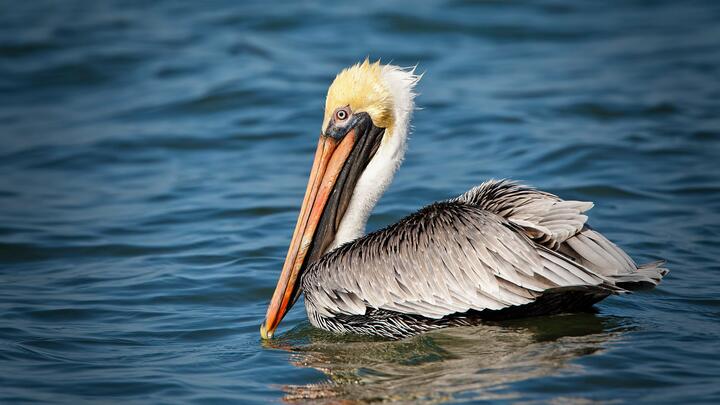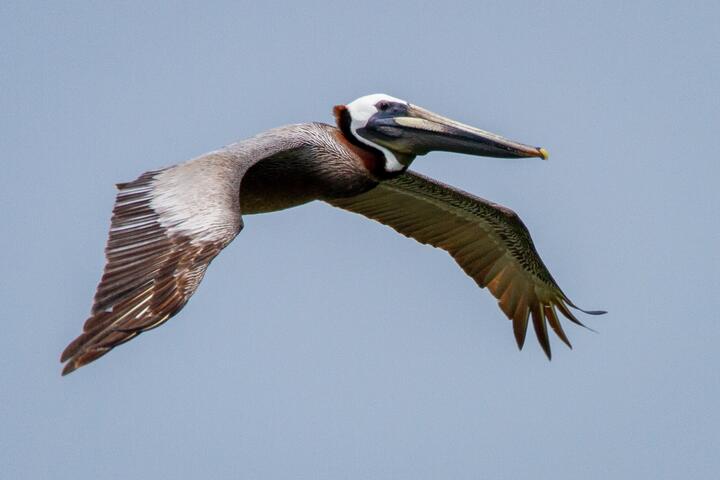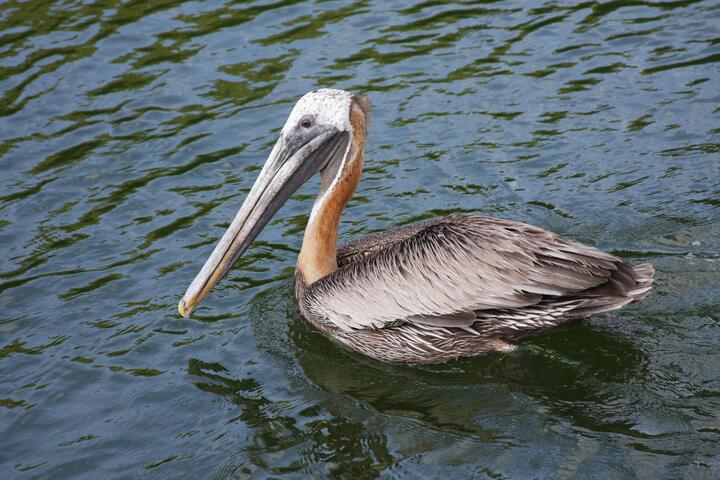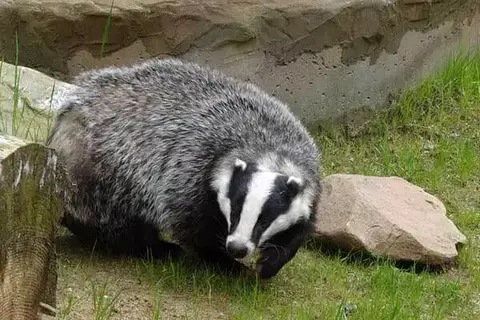Interesting Facts About The Brown Pelican
Evelyn StarWe’ve collected interesting facts about the brown pelican. The American brown pelican (lat. Pelecanus occidentalis) belongs to the Pelicanidae family. It is distinguished by its special fishing technique, which is not characteristic of all other related species except the Peruvian pelican (Pelecanus thagus). The birds look for their prey in the air and then half-fold their wings and fall down a downward trajectory, but do not dive deep into the water. Externally, they are very similar to each other and until 2007 were of the same species. In the late 19th and early 20th century, brown pelican feathers were widely used to decorate female hats. To preserve this species and other seabirds, the first wildlife reserve in the United States was established by order of President Theodore Roosevelt off the coast of Florida on March 14, 1903. The real threat to its existence arose during World War I. Soldiers of the American army were supplied with a large number of canned sardines. When this fish in the sea became scarce, fishermen began to kill brown pelicans on a massive scale, seeing them as their competitors. Their population decreased dramatically in the 1960s, due to the massive use of DDT. The dangerous insecticide led to very thin shells in bird eggs, which pelicans often crushed with their paws. The banning of DDT and the environmental measures taken allowed for the restoration of the population. Today, its population is estimated to range from 350 to 400 thousand adults.
Distribution of brown pelicans
 Photo by Philip Brown on Unsplash
Photo by Philip Brown on UnsplashThe habitat is located in North, Central, and South America. On the Pacific coast, brown pelican nests are located from northern California to Chile, and on the Atlantic coast, from South Carolina to Venezuela and the Caribbean islands.
Outside the breeding season, birds can migrate to Canada and Tierra del Fuego. Birds living in the Gulf of Mexico are predominantly sedentary. The direction of seasonal migrations is associated with the appearance of cold atmospheric fronts.
American brown pelicans settle on the sea coast or in mixed waters of river estuaries. Sometimes they fly deep into the USA and Brazil.
There are 5 subspecies known. The nominative subspecies are spread across the Caribbean islands and coasts of South America from Colombia and Venezuela to Trinidad and Tobago. The subspecies Pelecanus occidentalis urinator lives in Galapagos.
The behavior of brown pelicans
Brown pelicans are among the social birds that form numerous colonies. There can be up to 5-10 thousand nesting pairs in one colony. They often nest together with gulls (Laridae) herons (Ardeidae), cormorants (Phalacrocoracidae), and donkeys (Sulidae).
Representatives of this species very rarely come into conflict with each other. Individual distance between individuals and territorial demarcation is made by the rapid forward movement of the open beak. In the same way, American pelicans scare away small birds of prey.
As ground raptors approach, they rise, pull out their beaks, and wave their wings. If they still approach at close range, the pelicans fly away without delay and land on the water surface.
They like to fly low above the sea surface in small groups. During the flight, birds hold their heads on their shoulders and their beaks rest on folded necks. On long flights, the flock flies in the form of a Latin letter V, and on short distances, it lays in a row.
Feeding of brown pelicans
An American brown pelican looks out for its victim up to 20 m above the sea surface. When his beak hits the water, he sharply pulls back his wings and legs to reduce the resistance of the water environment. Air bubbles in the plumage in the abdominal region soften the impact and prevent it from completely submerging into the water, so only fish in the surface layer becomes its trophy.
When the beak is lowered into the water, the victim is between the upper and lower jaws. The beak closes instantly. By turning its head to the sides, the brown pelican is released from the excess water. As a result, only one booty remains in the throat bag.
The diet is dominated by California anchovies (Engraulis mordax), Peruvian sardines (Sardinops sagax), and Atlantic menhaden (Brevoortia tyrannus). Shrimp are often eaten, much less squid and octopus.
Feeding occurs in relatively shallow areas of the sea up to 150 m deep.
Usually, brown pelicans are looking for food only in areas where there are many shoals of small fish up to 18-21 cm long. Sometimes they eat amphibians, eggs, and foreign chicks. The daily consumption rate is about 2 kg of food.
Breeding of brown pelicans
 Photo by Joshua J. Cotten on Unsplash
Photo by Joshua J. Cotten on UnsplashSexual maturity comes at the age of 3-4 years. American brown pelicans form monogamous couples that last for one season and only occasionally for a longer period.
The marriage period begins in March and ends in April. At its beginning, males take up space for the future nest and wait for the females. While waiting, they write out loops with their heads that resemble a sign of infinity. The males do not leave the occupied area until they find a pair. It takes 2-4 days. The unlucky cavaliers wait for their half sometimes up to 3 weeks in a row.
The nest material is collected by the males, while the females build the nest. It is located both on the ground and in the tree crown. Construction work usually lasts 7-10 days.
After their completion, the average female lays the first white egg in 3 days. Two to three oval eggs of about 76×51 mm in size are laid at intervals of 24 to 64 hours.
The incubation lasts from 28 to 30 days.
The helmet is warmed by both spouses alternately. Eggs are heated using swimming partitions, through which a dense network of capillaries passes. Brown pelicans seem to “stand” on their eggs.
The chicks hatch naked and blind, with pink skin and weigh about 80 grams. For 4-14 days they are covered with dark fluff. Then they have layers of white, black, and grayish plumage.
For the first week, parents feed hatched chicks with porridge, which is burped from their stomachs. Then the offspring take their fish from their parents’ beak. On about the 35th day, the chicks leave the nest and walk in its surroundings. On the wing they become at the age of 72-80 days, staying close to their parents for another 5-7 months.
Description of brown pelicans
Body length 115-138 cm. Weight 2500-4000 g. Wingspan reaches 180-200 cm. Males are 15-20% heavier than females. The length of the beak is 25-38 cm. In males, it is about 10% longer.
Young birds are mostly painted brown with a white belly. Adult plumage appears at the end of the third year of life.
In sexually mature birds the upper part of the head and neck are whitish, with a slight yellowish tint. Chest and lower sides are blackish, with separate white feathers.
Legs and paws are black. A large throat pouch holds up to 11 liters of water.
The life expectancy of American brown pelicans is about 30 years.
Did you like interesting facts about the brown pelican? Share it with your friends.
Brown Pelican Fun Facts
 Photo by Karl Callwood on Unsplash
Photo by Karl Callwood on UnsplashBrown Pelican fun facts include their unique personalities, size, diet, and breeding habits. The white rhino is the largest of the species, weighing over 2 tons and standing more than 1.8 meters (6 feet) tall. Their long, sticky tongues are used to catch fish. While brown pelicans are not the largest of pelicans, they are still considered to be the world’s largest bird. Their large beaks are nine inches long, and they use their mouths to scoop out fish from 20 to 30 feet under the surface of the water. Their wings are covered with feathers, which are replaced by the skin when they are older.
Although pelicans are primarily known for consuming fish, they also eat a variety of crustaceans, turtles, amphibians, and other birds. Even humans can eat their meat because they will eat anything that fits in their mouths. Two species of pelicans actually dive for food! Read on for some brown pelican fun facts. This bird is found in Puget Sound and the Strait of Juan de Fuca.
The brown pelican is considered the state bird of Louisiana. It is the only bird featured on the official seal of the state. Though it is common today, the brown pelican has faced near-extinction in the past. Listed as an endangered species by the USFWS in the 1960s, the brown pelican is now thriving in the state and has become the state’s official bird. In addition to its beauty, the birds’ fascinating facts make them an excellent choice as a souvenir, educational gift, or addition to your home decor.
The brown pelican is the only species of pelican to dive into the water with its folded wings. It eats by using its pouch and bill like a net to scoop up fish. In addition to eating fish, the pelican uses its multi-purpose pouch as a fishing tool. However, less than 2% survive over a decade. It is important to note that only a small percentage of brown pelicans survive in the wild.
While brown pelicans are known for their scuba diving abilities, they are often monogamous. They breed for one season and do not usually mate for life. While they are very popular birds, they do not have much to do with their breeding habits. Unlike many other birds, brown pelicans do not lay eggs. The male lays two to three eggs. They are chalky white in color and incubate for 28 to 30 days. Incubated eggs are kept warm with their webbed feet. Chicks are born with no feathers. During this time, the birds feed the chicks with regurgitated food.
Brown Pelicans are extremely social. They live together for their entire lives, ranging from ten to thirty years. They also tend to tolerate other species, and the pesky seagulls often steal the fish from their beak. During their hunt, they are able to store enough food for a week. This means that the brown pelican can survive even in areas with high temperatures. If they are not in the ocean, the seagulls may be eating them.
The brown pelican is a member of the Pelecanidae family. This species has distinctive behavior and proportions. The brown pelican is the state bird of Louisiana. It is the smallest of the four pelican species. It is also the smallest of the four pelican families. It is found along coastal regions of North America and southern South America. Its gregarious nature is also an advantage in its breeding and hunting behavior.
The brown pelican has few predators in the wild. It is often preyed on by seagulls, stray cats, dogs, and alligators. In fact, the population of brown pelicans has risen since the ban of DDT. Its habitats are in the southern Atlantic and the Pacific Ocean. You can find this species in coastal areas of the world. The population is the only pelican species to grow taller than you and its eggs.
The brown pelican has a large, elongated bill. Its bill is very long and has a long beak. The bird can hold up to three gallons of water. During its first year, the male pelican is slightly heavier than the female. The adult brown pelican has black legs and feet. Throughout their lives, they hunt for fish. You can find the brown pelican in coastal areas and on the Galapagos Islands.
- WildlifeTop 10 Most Dangerous Animals In The World

- WildlifeFun Facts About A WallabyBy Evelyn Star

- RodentsFun Facts About MuskratBy Evelyn Star

- RodentsHamster Illnesses – Symptoms And TreatmentBy Evelyn Star

- Wildlife10 Interesting Facts About BadgersBy Lucas Torres

- Wildlife10 Interesting Facts About The European LynxBy Noah Young

- WildlifeStarfish Characteristics And FactsBy Murphy Scott

- Insects25 Amazing Facts About Honey BeesBy Murphy Scott

- InsectsLadybug’S Nest And Other Ladybug FactsBy Lucas Torres

- BirdsThe Cockatoos Danced To The Anthem Of The Fight Against CoronavirusBy Camilo Walker
